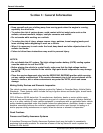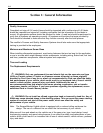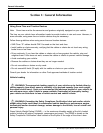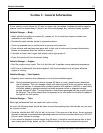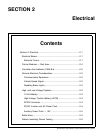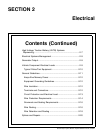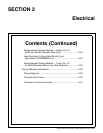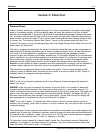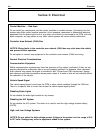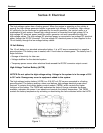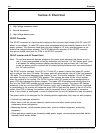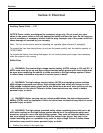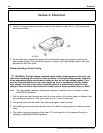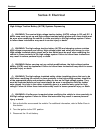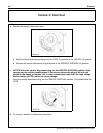
Electrical 2-1
Section 2: Electrical
Electrical Basics
Inside a vehicle, electricity is supplied through ‘‘hot’’ wires, comparable to the pressurized supply
pipes of a plumbing system. At various points along the wires are outlets in the form of lights,
switches and receptacles. Turning on a light switch is somewhat like opening a faucet to let water
run, an electric current flows through the hot wire to make the light glow. Once the electricity has
done its work, its potential drops to zero, just as water loses pressure after flowing through a sink
or laundry tub. The electrical system has ‘‘drains’’, which are the ground wires that return the
current to its source, just as a plumbing system has drain pipes through which water runs into the
sewer mains or the ground.
The light or equipment powered by the current, technically called the load, can be compared to a
water wheel that remains motionless until a stream of water causes it to turn. A load may be one
of 2 kinds. The first consists of a resistance, a material that permits the passage of electric
current, but only with difficulty and thereby creates heat. The tungsten filament of an incandescent
bulb is resistance; so is the heating element of an electric heater of a coffee pot. A load may also
be an inductance, typically a motor with windings of copper wire, in which the magnetic fields
generated by the current create motion. At any moment, the demand on an electrical system
depends on the number of loads in operation and their consumption of energy, just as demand on
a water system depends on how many faucets are opened and how wide they are opened.
The mechanics and physical fittings of the system are simple. Current moves throughout the
vehicle in wires of different sizes, according to the current a circuit may have to carry. Power is
supplied directly to equipment through connectors.
Electrical Terms
VOLT is the unit of electrical potential, equal to the difference of electrical potential between 2
points on a circuit.
AMPERE is the unit used to measure the amount of current, that is, the number of electrically
charged particles called electrons, that flows past a given point on a circuit each second. It is
similar to measuring the amount of water flowing through a pipe at any given point. The larger the
pipe is, the more water that can flow past the point per second. Similarly, the bigger the wire is,
the more current that can flow through it at any given point. Current that has lost its voltage still
has amperage as it completes the circuit and returns to the battery.
WATT is the unit of power. It indicates that rate at which a device converts electric current to
another form of energy, either heat or motion, or to put it another way, the rate at which a device
consumes energy.
The relationship of volts, amperes and watts to one another is expressed in a simple equation that
enables you to make any calculations you may need for proper and safe electrical modifications to
the vehicle. Volts x amperes = watts. If the current is at 12 volts and a device requires 4 amperes
of current, the equation will read 12 volts x 4 amperes = 48 watts.
To figure the current needed for a device rated in watts, turn the equation around: Watts/volts =
amperes. For example, if you have a piece of equipment, such as a communications radio, that
uses 120 watts: 120 watts/12 volts = 10 amperes.
2010 Escape Hybrid, Mariner Hybrid Modifiers Guide, 07/2009



